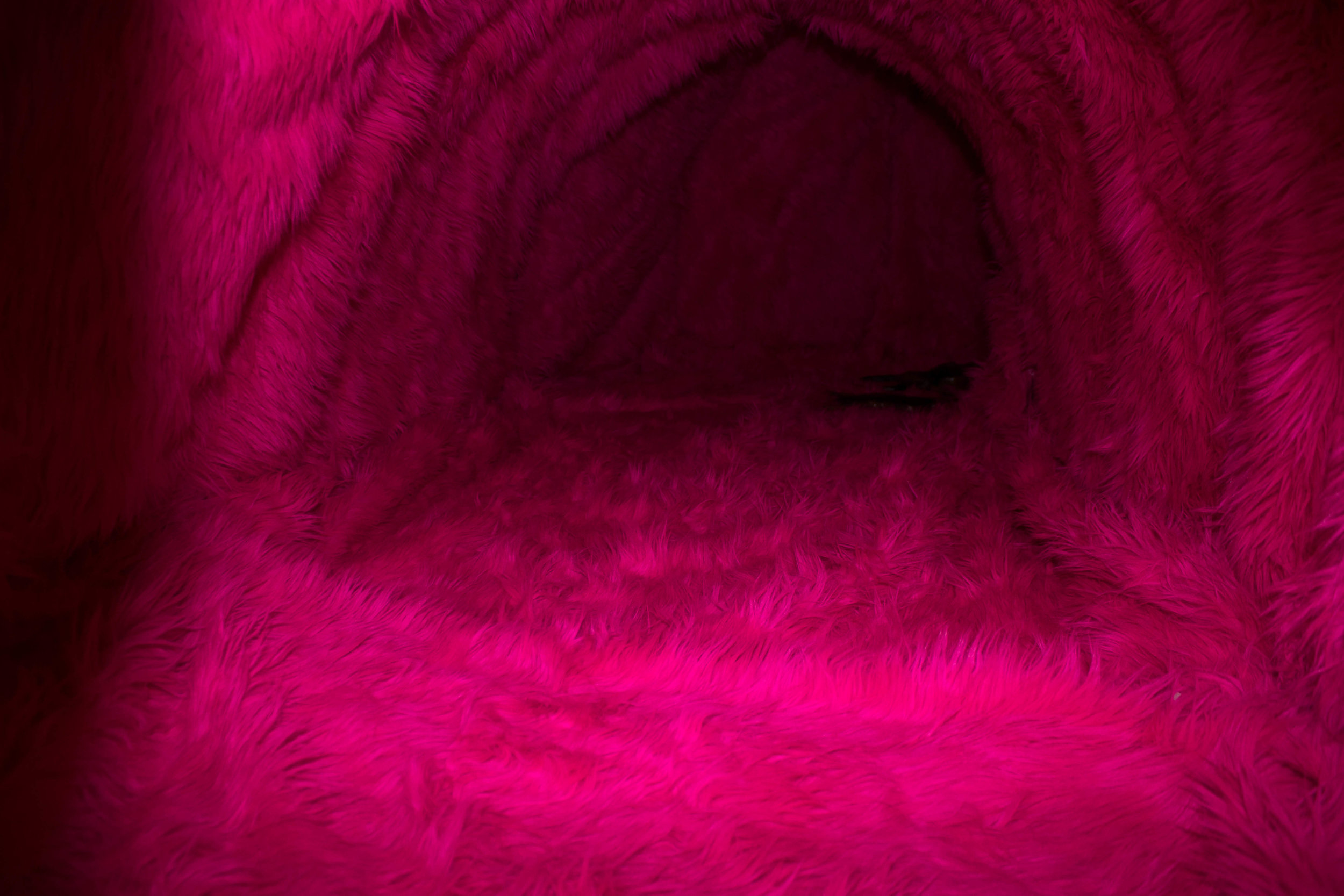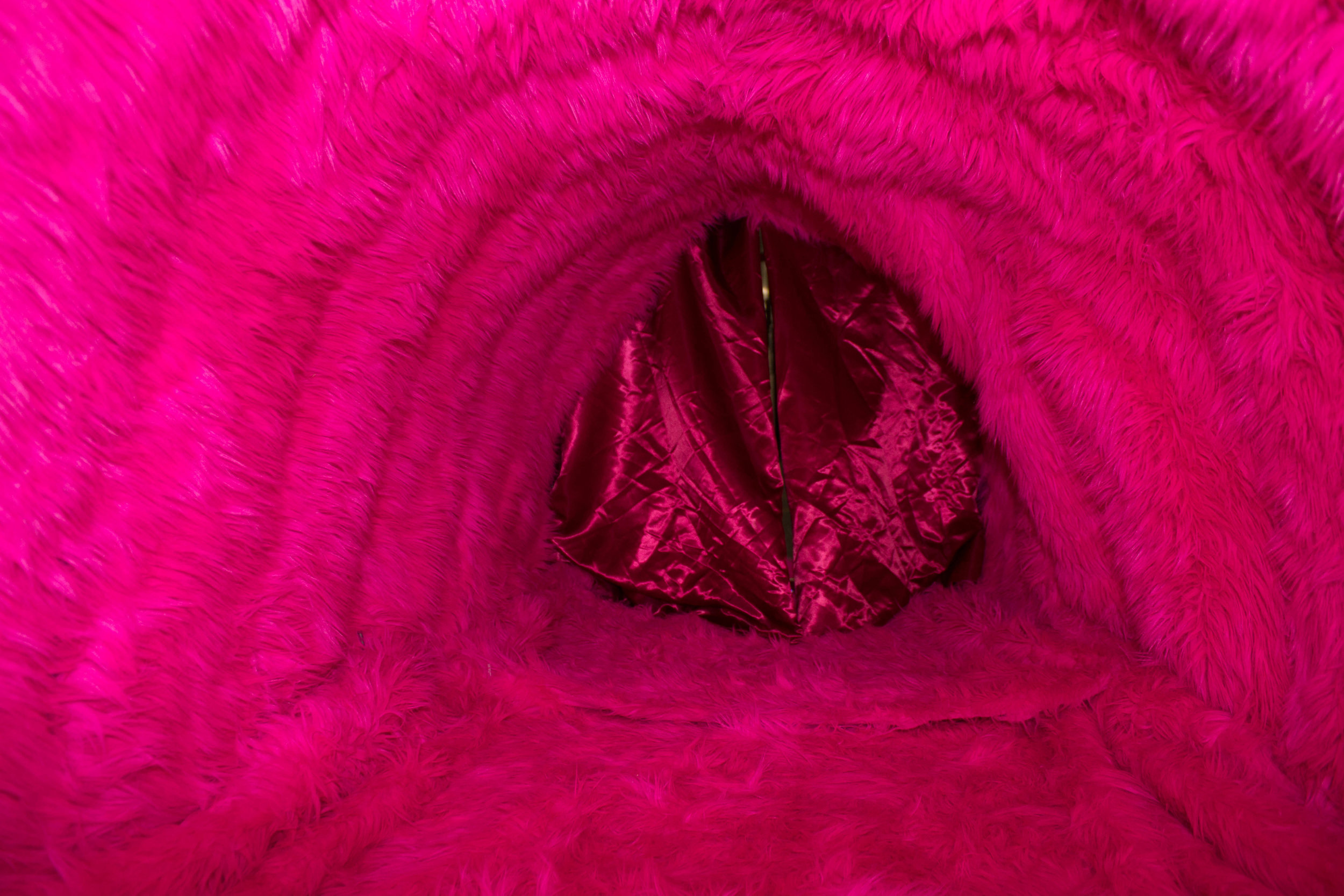







Installation, 2018
The concept of the wandering womb dates back to Ancient Egypt but became a recognized medical disease known as Hysteria in Ancient Greece during the 5th century with the rise of Hippocratic medicine. During this time women were treated with a wide range of invasive treatments including potions, perfumes, foods, drinks, insects, pessaries, etc. The only cures for hysteria were childbirth and intercourse. Hippocratic gynecology represents the long held view of the female body as something dirty needing to be cleaned. This installation acts as an interactive exhibit of an ancient womb, conveying the mysteriousness of these ancient treatments.
For my installation, The Wandering Womb in Ancient Greece, I focused on vaginal fumigations and cantharid beetles that were used to purge the body of excess, venomous fluids. I created a womb structure using aluminum hoops and 2 x 4 pieces of wood. I lined the structure with pink fur to represent the Plato quote which describes the wandering womb as an “animal within an animal.” The viewer crawls through the vaginal canal and into the womb to find four beetle carcasses, which represent the four beetles that the woman ingested orally as a treatment for Hysteria and fluid retention known as Hydroterma. The use of cantharide beetles is especially interesting because they were also known to be used by women to abort unwanted pregnancies. So on one hand you have them being used as a method of male control over the female body and on the other women having control over their own reproductive systems. I scented the space with Lavender oil because it was a popular essential oil in Ancient Greek medicine and represents the sweet smells that were used to lure the uterus back down. I wanted to fill the space with fog or steam, which would have signified the vapor baths and fumigations, however, I could not figure out how to execute this safely. I provided a flashlight for the viewer to guide them through the space and to further the concept of discovery and exploration. I scripted an audio piece which combined texts from writings by Plato and Hippocratic medical journals and played as the viewer inhabited the space. I chose to have a male narrator to reflect how the history of hysteria, gynaecology and medicine in general has largely been documented by men.
Through this installation I wanted to show the history and absurdity of gynecological medicine and hippocratic practices which were used for centuries and continue to shape our views of women’s bodies today. The idea that women’s bodies, specifically their genitals, are dirty and need to be cleaned is not only an ancient idea, and has been further perpetuated with the rise of capitalism. For example Gwyneth Paltrow just started a new vaginal steaming company, and douches and other vaginal cleansing products have been on the market for years. While these hippocratic practices may seem extreme or weird, our views on female genitals and reproductive systems are byproducts of these practices and ideas. This installation is meant to make the viewer question the contemporary relevance of these practices and the absurdity of our own feminine hygiene and medical treatments.
Audio
"In the middle of the flanks of women lies the womb, a female viscous, closely resembling an animal; for it moves itself hither and thither in the flanks, also upwards in a direct line to below the cartilage of the thorax, and also obliquely to the right or to the left, either to the liver or the spleen; and it likewise is subject to prolapsus downwards, and, in a word, it is altogether erratic. It delights, also, in fragrant smells, and advances towards them; and it had an aversion to fetid smells and flees from them; and, on the whole the womb is like an animal within an animal.”
In Ancient Greece Doctors prescribed all kinds of different remedies to lure the uterus back to its seat. In the case where the womb has moved towards the liver, the doctor will push it down and then tie a bandage below the ribs to stop it from rising again. Other Hippocratic treatments involved potions, fumigations, and hot and cold baths. But sex and pregnancy were the ultimate cures. It was thought that when a women does not have intercourse, her womb becomes dry, and is liable to become displaced.
To cleanse the body of venomous fluids, sweet-smelling vapors were burnt beneath her womb. For uterine prolapse a vapor bath made from cow dung followed by pessaries made from cantharid beetle was used. To purge the womb of fluid and induce menstruation, women would ingest recipe of four cantharid beetles and four dark peony seeds, cuttlefish eggs, parsley and wine.